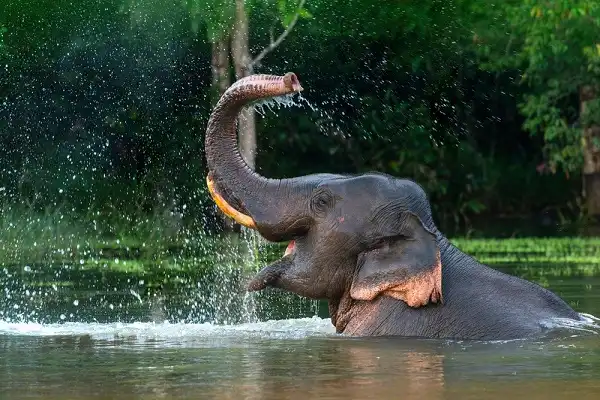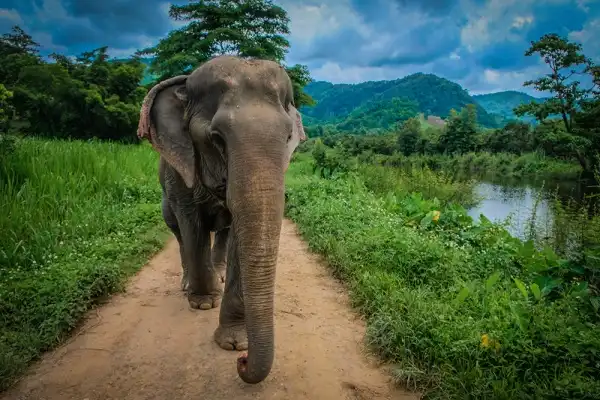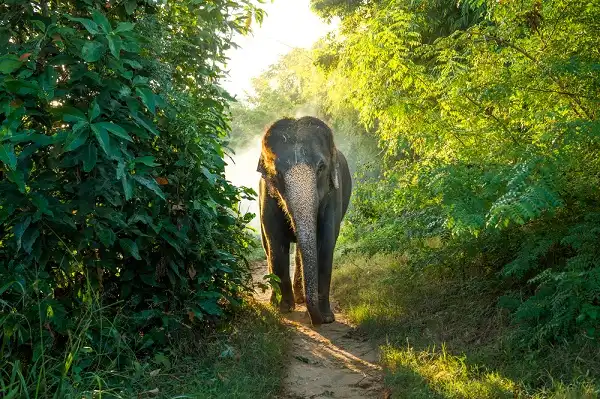Have you ever wondered what it would be like to come face-to-face with an Asian elephant? With their grey skin, long trunks, and tall stature, these majestic creatures have captivated the hearts of wildlife lovers all over the world for centuries. Seeing an elephant in its natural habitat makes a person realize just how incredible and powerful they are, but there is much more to these animals than meets the eye! Today we’ll take a look at why Asian elephants warrant our attention and discuss some facts about their behavior, habitat needs, and conservation efforts.

Asian Elephant Description
The Asian elephant, known scientifically as Elephas maximus, is one of the two species of elephant still in existence today. They are the largest land mammals. Their thick grey skin provides protection from injuries and parasites while their long trunks are used for grasping items, manipulating objects, and communication. Asian elephants have four legs that end in flat feet to support their huge bodies and give them a stable base. They also have large ears which they use to regulate their body temperature and to listen out for danger. Asian elephants typically have two protruding tusks which are actually modified teeth used for digging or defending themselves from predators. Males may also possess large temporal glands on either side of their heads that secrete a pungent-smelling fluid when they become sexually aroused or agitated.
Asian Elephant Habitat
Asian elephants are typically found in a variety of habitats, including rainforests, grasslands, scrublands, and savannas. They require large areas with plenty of food and water sources to thrive. Depending on their location, Asian elephants may occupy tropical or deciduous forests, mangroves, and even desert fringes where they can find fresh vegetation and water. Asian elephants often travel long distances in search of resources such as food and water. To do so, they must navigate complex terrain that includes wetlands, rivers, hillsides, and mountains. As such they are known for their extraordinary intelligence and ability to recall paths between these resources over long distances. Their habitats need to have sufficient vegetation to feed them while also providing adequate protection from predators.
Asian Elephant Diet
Asian elephants have a very varied diet that includes grasses, leaves, bark, roots, fruits, and even small animals. They tend to feed on whatever is available in their habitat at the time. For instance, in some areas, they may graze on grasses while in others they might feast on fruit or browse on tree branches. These animals are also known for their ability to break down tough plant material such as tree bark with their tusks and trunks. Asian elephants have been found to consume around 600 pounds of food per day in order to meet their caloric needs! In addition to plant matter, these massive creatures can also be seen snacking on small insects and other invertebrates. Elephants can reach food sources located as high as 16 feet off the ground by using their trunks. They will often use the trunk like a hook to pull branches or leaves down into their mouths. The trunk is also incredibly versatile and can be used to carry large objects such as logs or even entire trees!

Asian Elephant Size
Asian elephants are the largest land mammals on Earth and can reach up to 11 feet tall at the shoulder and weigh anywhere between 4,000 and 5,500 pounds! Depending on their age, sex, and subspecies, Asian elephants may vary in size. Females tend to be smaller than males while Indian elephants are generally larger than Sri Lankan or Sumatran ones. Their large size is due to a combination of factors including dense bones, thick skin, layers of fat and muscle, as well as long legs. These adaptations allow them to move quickly across long distances in search of food and water sources while also providing sufficient protection from predators.
Asian Elephant Lifespan
Asian elephants are long-lived animals, with an average lifespan of 60 to 70 years in the wild and even longer in captivity. The oldest recorded Asian elephant was an Indian cow that lived to be 86 years old! Females tend to live slightly longer than males due to a combination of factors including reduced levels of stress and access to more resources. However, overall life expectancy varies greatly depending on their habitat and the availability of food and water sources. In the wild, Asian elephants face many risks that can lead to premature death such as injury from predators or poaching, diseases, human encroachment, deforestation, and changes in climate. The older members are also very important for the survival of the group as they act as mentors for younger elephants; they teach them how to navigate their environment as well as skills needed for survival such as how to feed themselves or recognize potential danger. It is no surprise then that these animals put so much value into their elders, honoring them with special ceremonies prior to their passing!
Asian Elephant Behavior
Asian elephants are highly social and intelligent animals with complex behaviors that have been studied for centuries. They live in extended family groups of up to 10 related females and their young, led by the matriarch. The size and composition of these groups vary depending on the availability of food sources as well as other environmental factors. These animals are incredibly communicative, using their trunks to smell each other, touch one another, or even hold hands when feeling scared or threatened. Elephants also make diverse vocalizations including barks, trumpets, chirps, and rumbles; they use these noises to communicate with each other over long distances about mating opportunities or potential danger. Asian elephants often display cooperative behavior amongst members of their herd; they help the elderly and sick elephants by providing them with care and protection from predators. They also work together to find food sources or build shelters for the group during bad weather. This is in part due to the strong bonds formed between the members, which can often last a lifetime!

Asian Elephant Speed
Asian elephants are incredibly fast and agile creatures, capable of reaching speeds of up to 25 miles per hour over short distances. This impressive speed is made possible by a combination of factors including their powerful legs, large size, and thick skin. Additionally, their long trunks help them balance while running as well as provide them with an extra boost of momentum when they need it. Despite their size, Asian elephants are surprisingly agile climbers too! They are able to climb steep embankments in order to search for food or water sources and can even cross small rivers and streams. By using their trunk as a snorkel, they have even been known to swim through deep waters in order to reach islands that are otherwise inaccessible. Overall, the speed and agility of Asian elephants allow them to cover vast distances in search of food and water sources quickly while also providing protection from potential predators. This adaptation is essential for their survival and has enabled them to thrive in a variety of habitats ranging from tropical rainforests to dry deserts.
Asian Elephant Hunting
Asian elephant hunting has been a problem for centuries, with poachers targeting these majestic creatures for their ivory tusks or meat. Despite numerous efforts to protect them, illegal elephant hunting continues to be one of the major threats facing Asian elephants today. In some countries, elephant hunting is done legally by licensed hunters who must abide by strict regulations. Nonetheless, illegal killing remains a major concern as poachers often use snares or poisoned arrows to kill elephants without being detected. This type of hunting can result in the death of an entire herd due to the slow-acting poison used on the arrows. Fortunately, there have been many successful conservation efforts put into place in recent years that have helped reduce elephant poaching in some areas. These include increasing local law enforcement presence in at-risk areas as well as providing economic incentives for communities to switch from subsistence farming or hunting activities to other forms of livelihoods such as ecotourism operations.
Asian Elephant Reproduction and Life Cycle
Asian elephants have an incredibly fascinating and unique reproductive cycle that allows them to produce offspring in a variety of different ways. The average reproductive lifespan of these animals is between 15-20 years, with males becoming sexually mature at around 12-15 years old and females at around 10-12 years old. Females typically give birth to just one calf every 3-5 years; the gestation period lasts anywhere from 19 – 22 months depending on environmental conditions and the availability of food sources.
Calves are typically born weighing 100-150 lbs and will stay close to their mother during the early stages of life. Males will leave their family groups at around 8-10 years old in order to find other male elephants with whom they can form their own herds. This process, known as musth, occurs between December and April when bulls enter a heightened state of arousal which causes them to become more aggressive than normal. This behavior helps them establish dominance over other males while also attracting receptive females for mating purposes.

Conclusion
The Asian elephant is an incredible creature that has adapted to thrive in a variety of environments across Asia. Their impressive speed and agility allow them to cover vast distances quickly while also providing protection from potential predators. Unfortunately, the species still faces threats such as illegal hunting and loss of habitat due to deforestation and land conversion for agriculture. By understanding the reproduction, life cycle, and adaptation strategies of these animals, we can better appreciate their strength and resilience and take steps toward protecting them. With continued support from conservation efforts, we can ensure future generations of Asian elephants continue to thrive!
Frequently Asked Question


